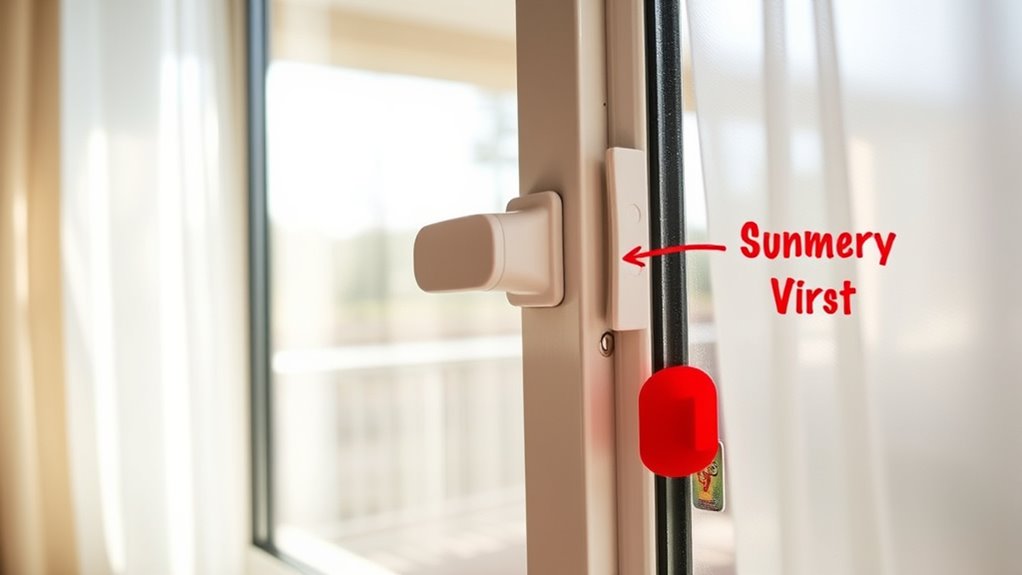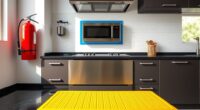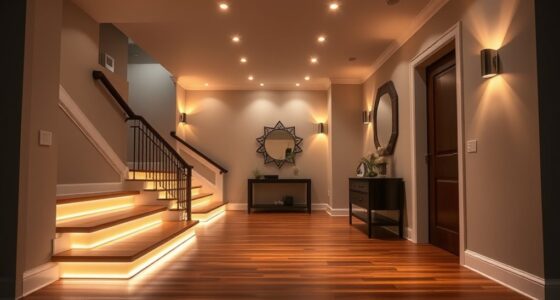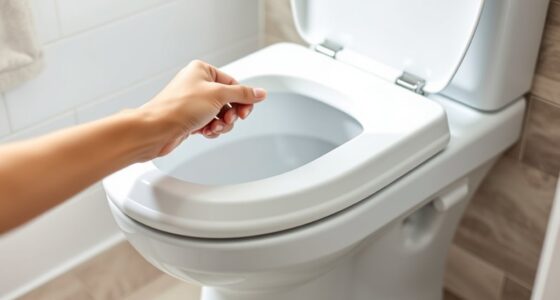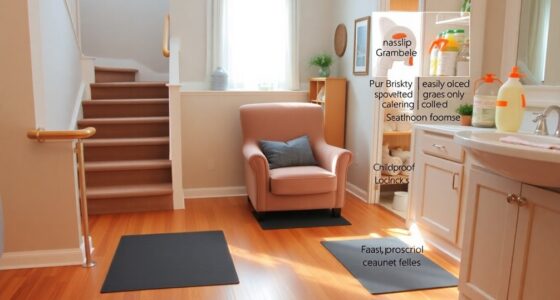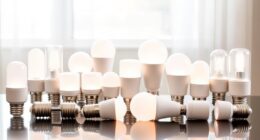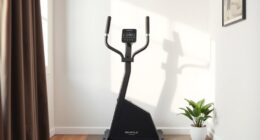To enhance window safety for someone with memory loss, you should install sturdy locks that are easy for caregivers to operate but hard for your loved one to open. Add window stops to limit how far a window can open and prevent falls. Incorporate signals or alarms that alert you when a window is opened unexpectedly. Combining these safety measures creates a secure environment while allowing necessary airflow. Keep exploring to discover more practical tips for maintaining a safe home.
Key Takeaways
- Install sturdy, easy-to-operate locks that prevent accidental or unauthorized window opening.
- Use adjustable window stops to limit how far a window can open, preventing falls.
- Incorporate window alarms or sensors for immediate alerts when windows are opened.
- Place locks, stops, and signals out of reach to reduce manipulation risks for individuals with memory issues.
- Regularly inspect and maintain safety devices to ensure continuous protection and proper functioning.
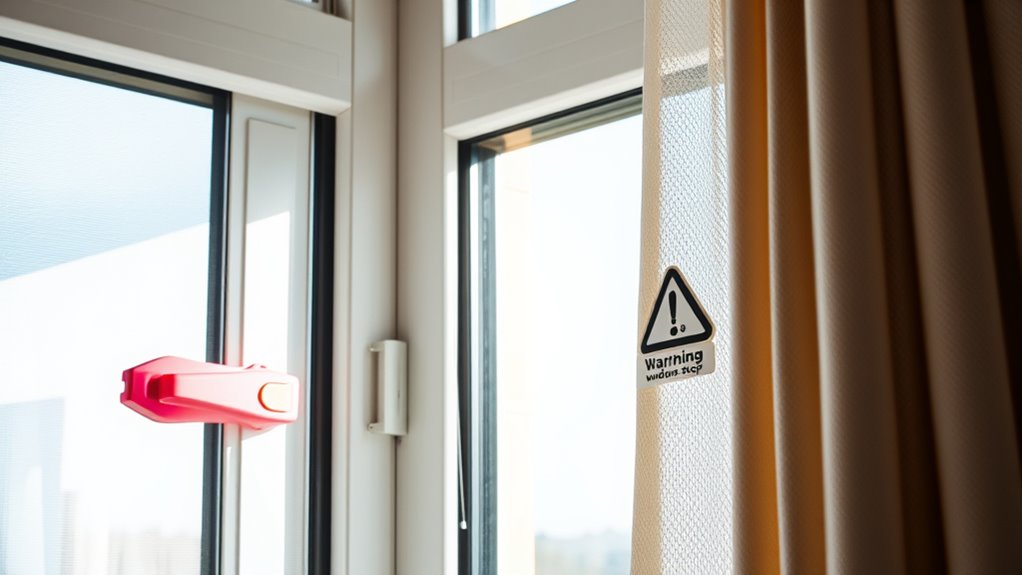
When someone with memory loss is living at home, windows can pose extensive safety risks if not properly secured. It’s easy to underestimate how quickly a person with memory challenges might forget safety precautions, which can lead to dangerous situations. That’s why installing secure locks, stops, and signals is essential to prevent accidental falls or escapes. You need to think proactively about how to make windows safer without making your home feel restrictive or uncomfortable. Start by choosing locks that are sturdy but also simple for you to operate if needed. Key locks or sliding lock mechanisms can be effective because they deter a person from opening the window without making it impossible for you to shut or open the window when necessary. Consider high-mounted locks or those that require a key to open, which are especially useful if your loved one tends to be curious or impulsive.
Secure locks, stops, and signals are vital for window safety with memory loss.
In addition to locks, window stops are invaluable safety features. They act as physical barriers that limit how far a window can open, preventing it from opening wide enough for someone to fall out. You can install stops on both the inside and outside of the window frame, depending on the type of window. These stops are adjustable, so you can set the opening limit based on your comfort level and the needs of the person living in the home. They’re a simple, cost-effective way to give you peace of mind, especially during warmer months when windows are open more frequently. Additionally, choosing childproof window locks can provide added security by making it more difficult for someone with memory issues to bypass safety measures.
Signals, such as window alarms or sensors, serve as an extra layer of security. When a window is opened, these devices emit a loud sound or send a notification to your phone, alerting you immediately. This instant alert can make a difference if your loved one tries to leave the house without your knowledge. It’s especially useful if you’re not always in the same room or if you’re asleep. Some alarms can be discreet, so they don’t draw unnecessary attention but still provide a reliable warning system. Using a combination of locks, stops, and signals offers an extensive approach to window safety.
You should also consider the overall placement and accessibility of windows. Avoid placing furniture or other objects that could help someone climb up to open a window. Keep window cords and hardware out of reach to prevent strangulation risks or accidental pulling. Regularly check that all safety devices are intact and functioning properly, replacing or repairing them as needed. By taking these steps, you create a safer environment that respects your loved one’s independence while markedly reducing the risk of injury or escape.
Frequently Asked Questions
How Can I Discreetly Monitor a Loved One’s Window Access?
You can discreetly monitor your loved one’s window access by installing motion-activated cameras or sensors near the windows. These devices alert you when the window is opened or closed without being overly obvious. You might also use smart window locks that send notifications to your phone. Keep in mind, it’s important to balance safety with respect for their privacy, and discuss your concerns openly when possible.
Are There Specific Window Locks Recommended for Dementia Patients?
Yes, there are specialized locks designed for dementia patients, like key locks, latch guards, or window alarms. These keep your loved one safe without making them feel like they’re locked in a fortress. You’ll love the peace of mind knowing they can’t accidentally escape, while the locks blend seamlessly into your home decor. Just remember, safety first — and a little discreet security never hurt anyone!
Can Window Alarms Be Integrated With Home Security Systems?
Yes, you can integrate window alarms with your home security system. Many modern alarms are compatible and can be connected through wireless or wired systems, allowing you to monitor window activity remotely. This integration enhances safety by alerting you immediately if a window is opened unexpectedly. Make sure to choose alarms that are compatible with your existing security setup and consult a professional for proper installation and integration.
What Are the Best Signs of Window Safety Hazards in Homes?
You should look for windows that are easily accessible, especially on the ground floor or upper levels. Check for loose or broken locks, screens that don’t fit properly, or windows that open wide enough for someone to slip through. Also, be cautious of windows with obstructed views or missing signals like alarms. Regularly inspect these areas to guarantee your home remains safe and secure against potential hazards.
How Do I Balance Safety Measures With Independence for Someone With Memory Loss?
Think of safety measures as gentle anchors that keep your loved one secure while allowing freedom to explore. You can install locks that look unassuming but are functional, add signals or alarms that act like guiding stars, and use stops that serve as gentle boundaries. Regularly communicate and involve them in safety routines to foster trust, helping them feel independent without risking their safety. Balance is about blending protection with respect.
Conclusion
By installing locks, stops, and signals, you’re building a sturdy shield around your loved one’s world. Think of these safety measures as gentle guardians, quietly watching over open windows like loyal sentinels. With these tools in place, you create a safer environment where their independence can flourish without the threat of danger lurking like shadows in the corners. Ultimately, you’re turning your home into a fortress of care, where peace of mind blossoms like a well-tended garden.
